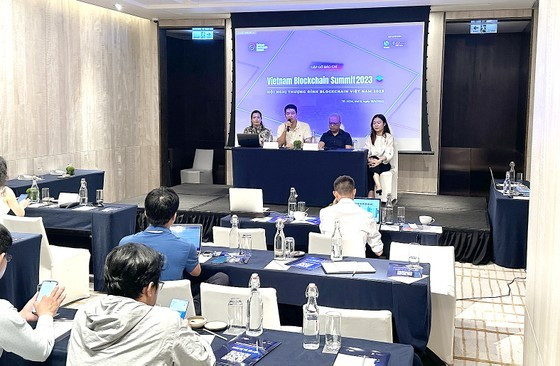Looking at bitcoin mining below the surface

Bitmain Antminer S19j Pros immersed in liquids that continuously remove heat. Each tank has its own arrangement of machinery that best maximizes cooling. Photo: Brady Dale/Axios.
The first thing you notice about CleanSpark’s new 20-megawatt submersible mining facility in Norcross, Georgia: It’s not loud.
Why it’s important: Noise is just one of the many complaints communities have had about bitcoin miners. CleanSpark, a Las Vegas-based energy company turned bitcoin miner, invited the press to its new facility last week to show that it is operating in the open.
- Inside you can hear the machines, but it’s not overwhelming, you can chat at normal volume. The cooling unit outside is also not that tall, especially for the commercial, light industrial area it is in.
Of the note: Outsiders don’t get to see the inside of bitcoin mining facilities very often. This reporter has been covering crypto full-time since 2017, but this was his first time inside one, see below:


Background: Bitcoin is the world’s oldest cryptocurrency. It guarantees that a single bitcoin cannot be used more than once by using a system called “proof-of-work”, which basically makes it too expensive to publish a fake transaction.
- Proof-of-work basically requires a miner to encrypt a set of transactions using a well-known algorithm and then guess the solution to that encryption. This requires trillions of trials with specially designed machines.
- The miner who completes that task first gets the transaction fees for that block plus the new bitcoins allocated for that block (currently 6.25, worth over $12,000).
What they say: “Bitcoin historically has had a bit of a negative connotation,” chairman S. Matthew Schultz acknowledged at the event, which aimed to show how his company was taking a community-friendly approach.
Be smart: This is not your normal bitcoin mining facility, although there is a good chance that more and more will look like this in the future.
- This plant uses what is called “immersion mining”, which means that the machines work completely submerged in a flowing synthetic oil that absorbs the heat generated by the machines.
- Typically, miners are air-cooled, with lots of fans, which generate a lot of the noise.
- Of the note: Dredging technology has been around at one level or another since at least 2006, and in recent years has taken off with miners. They have been experimenting with it as far back as 2013.
says CleanSpark that this approach will have other benefits, such as using less energy for cooling and extending the life of their machines. Schultz said they hope to get seven years out of the machines seen here, although the normal life is five.
- Meanwhile, immersion allows CleanSpark to overclock the miners, getting something like 20% more hashpower (the aforementioned guesses, basically) out of each machine than advertised.
- CEO Zachary Bradford explained to Axios that this is what makes immersion the most profitable approach in the long term. They may have lower overhead with airflow, but they can’t squeeze as much bitcoin out of those machines.
How it works: These are S19j Pro machines from Bitmain. They are built to be air cooled with built in fans. CleanSpark removes the fans and replaces the firmware with its own.
- The machines are then submerged in tanks of the non-conductive synthetic oils seen here. The fluids are pumped over the machines to collect the heat they generate while they are running.
- That heat is then transferred to water that is pumped to an external cooler. Once the water’s heat has been transferred to the air, the water is recycled back in to do it again.
Energy consumption is another hot topic in mining.
- CleanSpark buys emission-free power from Georgia Power. It is largely nuclear power, but with classic renewable energy in the mix. There was also talk of building a solar cell for the plant in Norcross.
- “We actually operate with carbon neutrality,” Schultz said. “We’re not going to operate somewhere we can’t access renewables.”
Driving the news: CleanSpark cut ties with local dignitaries, in part to show that the company had met with community leaders before setting up shop. Here are some community benefits they highlighted at the clip:
- Employs 20 people with an average salary of $48,000 per year.
- Five scholarships for computer science students seeking an associate’s degree at a local community college.
- 50 million dollars in local investment to date with a planned 145 million dollars in total over five years.
With the numbers: Across all of its facilities, CleanSpark had mined 3,768 BTC over the lifetime of the firm, but Q3 2022.
- It has $10.5 million in digital assets, which would be roughly 525 BTC (the company only mines bitcoin).
- The firm mined 384 BTC in July, but chairman S. Matthew Schultz told Axios that it uses mined bitcoin to cover operating and capital expenses first to avoid diluting shareholders or going into significant debt.
This approach has allowed it to pick up several mining machines at a discount through the bear market.
- The company currently mines around 3 exahashes, but projects to mine 20 by the end of next year.
Bottom line: CleanSpark has been an energy company since 1987. It got into bitcoin as energy entrepreneurs learning about bitcoin, not bitcoin entrepreneurs learning about energy.
























